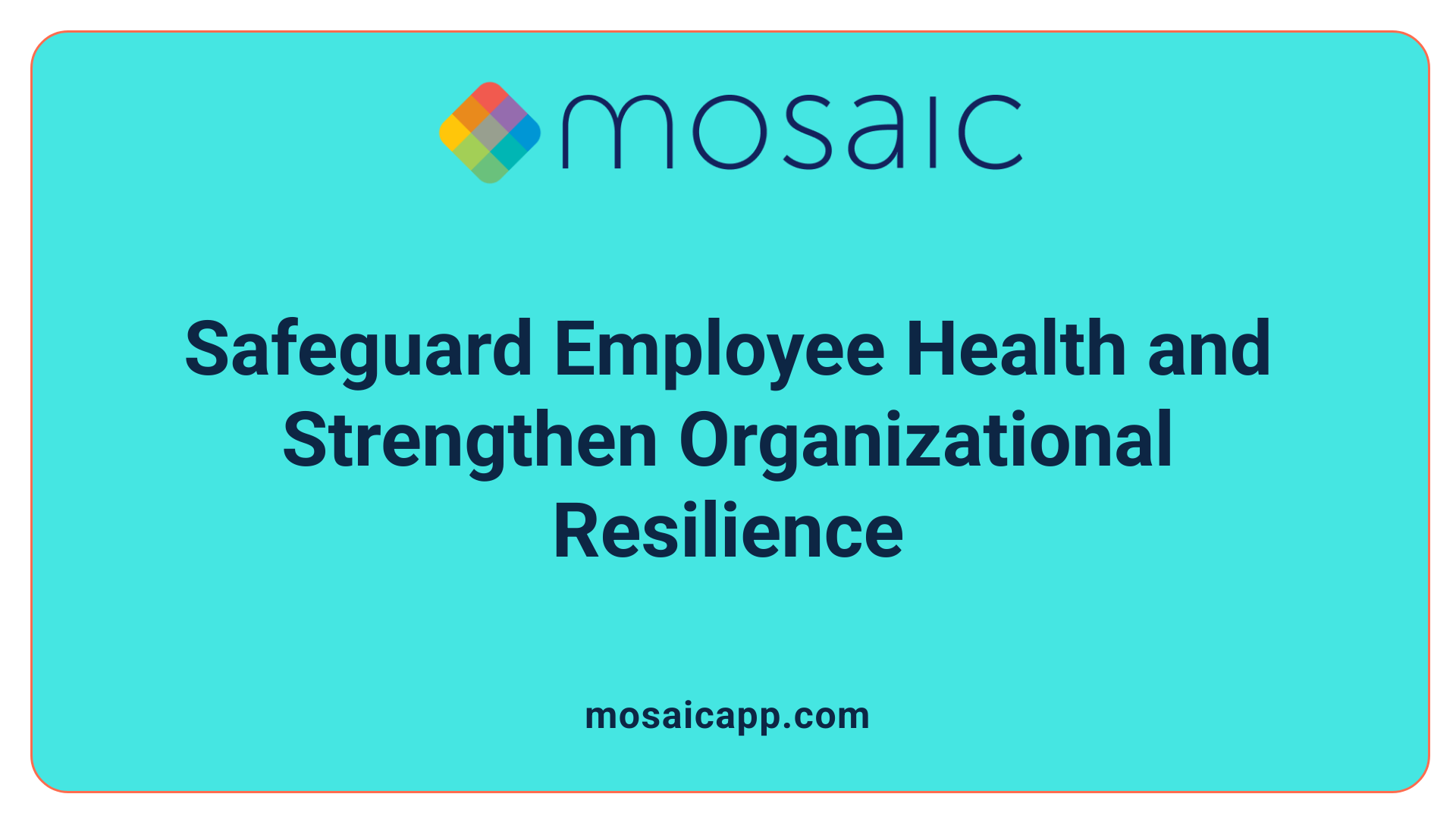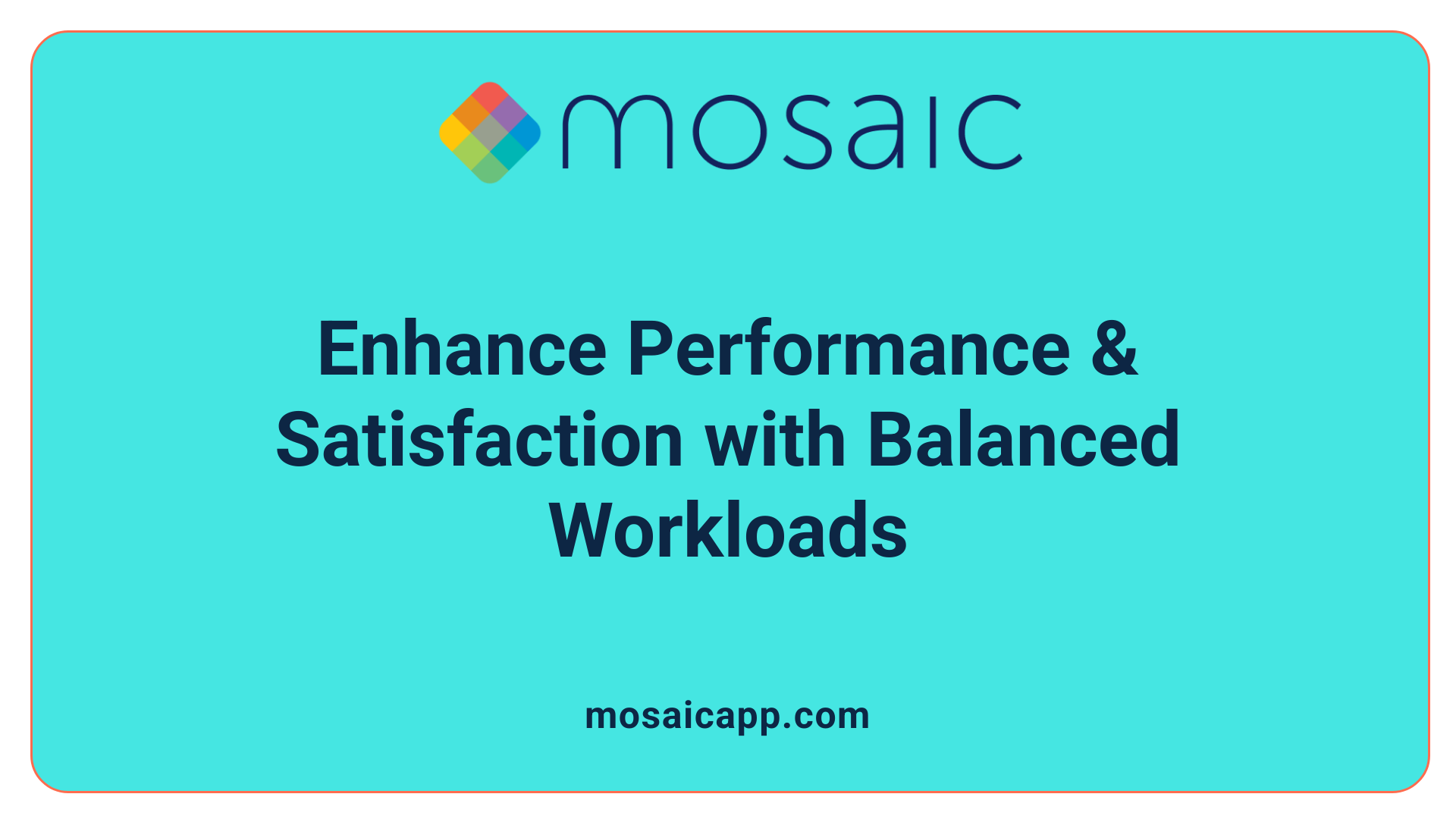Understanding the Critical Role of Workload Management
In today's fast-paced work environment, the risk of team burnout is an escalating concern that impacts organizational resilience, employee well-being, and overall productivity. As teams face increasing demands, effective workload balancing emerges as a vital strategy to prevent burnout, enhance performance, and promote a healthier workplace culture.
The Impact of Workload Imbalance on Team Well-being and Organizational Success

Why workload imbalance causes burnout
Workload imbalance occurs when team members are overburdened with tasks or have uneven distributions of work. This often leads to increased stress levels and feelings of being overwhelmed. When employees face high pressure without adequate support or clear role definitions, burnout can become a reality. Significantly, ambiguity in roles can reduce efficiency by up to 30%, making it harder to manage workload properly.
Effects on employee health and morale
Burnout manifests through symptoms such as irritability, fatigue, difficulty focusing, and emotional fragility. These signs can severely affect employee health, leading to issues like sleeplessness, headaches, and chronic anxiety. The physical and mental toll reduces motivation and productivity, causing a decline in overall morale. Nearly half of German employees report feeling burned out, which is linked to serious economic costs, including 59 million lost workdays due to psychological illnesses.
Organizational consequences such as high turnover and reduced productivity
High workload imbalance directly impacts organizational success. It results in increased staff turnover, absenteeism, and errors, while decreasing innovation and customer satisfaction. Companies suffering from burnout may face elevated costs related to sick leave and recruitment. Moreover, teams experiencing high stress levels often see a decline in team cohesion, passion, and overall performance. Effective workload management—through strategic planning, resource allocation, and fostering open communication—can mitigate these risks, leading to healthier work environments and improved organizational outcomes.
| Aspect | Details | Additional Consideration |
|---|---|---|
| Burnout Signs | Irritability, fatigue, focus issues | Early detection through regular check-ins |
| Health Impact | Anxiety, headaches, sleep issues | Encourages wellness resources |
| Organizational Costs | High turnover, errors, absenteeism | Implementing flexible scheduling |
| Productivity | Decrease due to overwork | Use of AI for workload balancing |
| Solutions | Clear roles, automation, communication | Promote work-life balance and employee support |
Efficient workload management, along with supportive workplace policies, is essential for maintaining employee well-being and securing long-term organizational success.
Identifying Signs and Causes of Burnout in Teams
How can organizations identify signs and causes of team burnout related to workload management?
Recognizing burnout early is essential for maintaining a healthy and productive team. Organizations can spot signs through both overt symptoms and subtle behavioral changes.
Common symptoms include fatigue, emotional exhaustion, and a noticeable decline in motivation and productivity. Employees may appear physically drained, struggle to concentrate, or become less engaged with their work.
Behaviorally, signs such as missed deadlines, decreased work quality, or social withdrawal from colleagues can signal burnout. Increased absenteeism and irritability are also critical indicators.
On an organizational level, factors like role ambiguity, poor planning, and resource shortages contribute heavily to burnout. These issues often lead to workload imbalance and player frustration.
To detect these signs early, companies should implement regular performance reviews, employee feedback sessions, and mental health check-ins. Tracking work hours via time management tools helps identify excessive workloads.
Addressing the root causes involves improving planning and communication, clarifying roles, and managing expectations effectively. Adjusting workload distribution, offering support resources, and fostering open dialogue about stress are practical steps.
By combining observation with strategic interventions, organizations can prevent burnout from escalating, ensuring team resilience and ongoing performance.
Main Reasons Behind Workload-Driven Burnout
What are the main reasons why teams experience burnout due to workload imbalance?
Teams often face burnout when workload distribution is uneven or poorly managed. When some team members are overloaded with tasks while others have less to do, it creates sustained stress and fatigue that can harm overall productivity and morale.
Organizational factors play a significant role in this imbalance. Restructuring initiatives, inadequate delegation, and unclear project priorities can leave employees confused about expectations and responsibilities. Lack of proper tools or systems for workload monitoring further worsens the situation, making it difficult to assess and adjust task assignments effectively.
Signs of workload imbalance include noticeable changes in employee behavior, missed deadlines, reduced work quality, and increased staff turnover. These symptoms not only reflect internal stress but also diminish trust and cohesion within the team.
Additional issues such as role ambiguity, where employees are unclear of their responsibilities, decrease efficiency by as much as 30%. When employees do not feel in control or supported, or face high job demands and strict deadlines, the risk of burnout rises sharply.
To prevent these problems, organizations should focus on fair task distribution, effective delegation, clear role definitions, and robust management practices. Using workload and capacity planning tools, fostering open communication, and ensuring support systems are in place contribute to healthier work environments.
Addressing workload imbalances through strategic planning and management leads to decreased burnout risks and helps sustain long-term team performance.
Strategies for Smarter Workload Balancing
What strategies can be used for smarter workload balancing to improve team performance and well-being?
Implementing effective workload management involves a range of strategies designed to optimize team performance while safeguarding well-being. One proven approach is utilizing visual management tools like Kanban boards, which provide clear visibility into tasks at various stages. This helps teams identify bottlenecks early and redistribute work to prevent overload.
Prioritizing tasks based on their impact and urgency is crucial. Frameworks such as the Eisenhower Matrix or the 4D System (Do, Defer, Delegate, Drop) help teams concentrate on high-value activities, reducing unnecessary stress and focusing efforts where they matter most.
Shared accountability methods, like the Getting Things Done (GTD) system, promote clarity around individual responsibilities and foster a culture of mutual support. These techniques encourage team members to take ownership of their tasks while maintaining transparency.
Real-time workload visibility is another vital element. Utilizing digital tools that track task progress and team capacity allows managers and staff to make proactive adjustments, preventing burnout and balancing workloads dynamically.
Complementing these processes with regular team check-ins creates space for open dialogue around challenges and workload concerns. Coupled with flexible scheduling options, such as adjustable hours or remote work, these practices help accommodate individual needs and reduce stress.
By integrating automation, workload assessments, and communication strategies, teams can create a balanced environment that boosts productivity while maintaining employee health. This comprehensive approach ensures work is distributed effectively, well-being is prioritized, and teams remain resilient and engaged.
Implementing Effective Workload Distribution Solutions

What are some solutions and best practices for implementing smarter workload distribution?
To effectively distribute workloads, organizations should leverage a variety of strategies and tools that foster balance and efficiency. Utilizing workload management software provides clear visibility into each team member's capacity, making it easier to allocate tasks based on real-time data.
Regular check-ins and open lines of communication are essential for early detection of overloads. These discussions enable managers and team members to address potential issues promptly, preventing burnout and missed deadlines.
Prioritizing projects according to their importance and deadlines helps streamline efforts and ensures that the most critical tasks receive appropriate attention. Aligning tasks with individual skills enhances productivity and fosters a sense of fairness and engagement.
Involving team members in planning processes encourages ownership and transparency. This collaborative approach supports the development of personalized workload strategies and boosts morale.
Implementing agile methodologies allows teams to adapt quickly to changing demands, promoting continuous improvement and flexibility.
Automation plays a vital role by reducing repetitive tasks, freeing up human resources for more strategic work. Combining automation with continuous monitoring of workloads ensures tasks are evenly distributed, and capacity is maximized.
Encouraging employees to actively participate in developing their workload management techniques fosters ownership and accountability. Regularly assessing workload distribution helps identify imbalances early, supporting wellbeing and sustained productivity.
In summary, combining technology, clear communication, strategic planning, and automation cultivates an environment of smarter workload distribution, reducing burnout risks and enhancing overall team performance.
The Link Between Workload Balancing and Workplace Productivity

What role does workload balancing play in sustaining team productivity and mental health?
Effective workload balancing is a cornerstone of a healthy and productive work environment. When workloads are uneven or overwhelming, teams are at greater risk of burnout, which can lead to high staff turnover, low morale, and decreased performance.
Balancing tasks ensures that employees spend time efficiently on billable work, with metrics like utilization rates guiding how workload is managed. For example, setting benchmarks such as 85% for account associates and 70-75% for managers helps optimize capacity without overloading. Use of time tracking tools like Toggl Track enables managers to see how tasks are distributed, revealing bottlenecks and resource gaps.
Smartly combining automation with human judgment is also critical. Automating repetitive tasks frees up time, allowing employees to focus on strategic and creative work. AI integration further reduces manual effort by up to 40%, and AI-driven scheduling can save up to six hours per week for employees. These improvements foster better work-life balance and diminish the chances of burnout.
A clear division of roles is vital; ambiguity can reduce efficiency by up to 30% and cause stress. Covering responsibilities clearly boosts team efficiency by over 50%. When teams understand their roles and have resources like flexible schedules, wellness programs, and regular communication, stress-related absenteeism can drop by approximately 43 days yearly.
Monitoring key metrics such as profitability, account efficiency, and staff utilization helps identify early signs of burnout. Open dialogue about workload stress and tracking of overtime hours make early intervention possible. Cultivating a supportive culture that encourages feedback and adaptability strengthens mental health and sustains motivation.
In conclusion, balanced workloads not only maintain high levels of productivity but also safeguard employee mental health. When organizations prioritize fair task distribution and leverage technology and supportive policies, they create resilient teams capable of delivering consistent results while enjoying better well-being.
The Consequences of Imbalance: Employee Health and Organizational Resilience

How does workload imbalance impact employee health and organizational resilience?
Workload imbalance has a profound effect on both individual employees and the overall organization. When employees are overburdened, it leads to increased stress levels, emotional exhaustion, and burnout. These conditions are not just short-term challenges; they can cause long-term health issues such as headaches, sleep disturbances, and chronic anxiety.
In addition to personal health problems, workload imbalance hampers organizational resilience. High workloads can result in elevated staff turnover as employees leave due to dissatisfaction or burnout. This turnover creates a cycle where remaining staff are further stretched, reducing the organization’s capacity to deliver quality service and adapt to changes.
Limited job autonomy and insufficient resources exacerbate these issues. When employees feel unable to manage their workload effectively or lack support, stress intensifies. Conversely, supportive policies such as flexible work schedules, autonomy in task management, and access to wellness resources can help bolster resilience.
Particularly in high-demand sectors like healthcare, managing workload is critical. Mental health professionals, public health workers, and other frontline staff often face relentless pressure. Organizational support that includes workload management, self-care initiatives, and psychological safety enhances their ability to maintain well-being.
Addressing workload imbalance through targeted strategies—like smarter task allocation, use of automation, and open communication—can not only improve employee health but also fortify the organization’s ability to withstand challenges. By investing in such measures, organizations foster a healthier, more resilient workforce capable of seamless service delivery and adaptation in a dynamic environment.
Ultimately, balancing workload effectively prevents burnout, supports employee well-being, and creates resilient organizations equipped to face future demands.
The Economic and Productivity Cost of Burnout
How does burnout impact employee health and organizational resilience?
Workload imbalance has significant consequences for employee health, often leading to increased stress, emotional fatigue, and burnout. These health issues not only diminish individual well-being but also reduce their capacity to perform effectively. When employees experience chronic stress without adequate support, their resilience wanes, making them more vulnerable to illness and decreasing their overall productivity.
At the organizational level, high workloads contribute to higher turnover rates as employees seek relief or better work environments. This turnover can disrupt workflow, increase recruitment costs, and reduce organizational knowledge continuity. Additionally, strained work environments can hinder adaptability and responsiveness, vital traits for sustaining long-term success.
Limited job autonomy and insufficient capacity to manage tasks intensify these challenges, creating a cycle of declining performance and morale. To combat this, organizations can implement supportive policies such as giving employees more control over their work, fostering social support networks, and encouraging self-care practices. Especially in demanding fields like healthcare, managing workload effectively is essential to protect employee health and maintain organizational function.
By addressing workload imbalance proactively, organizations foster healthier, more resilient teams capable of enduring pressures without compromising performance. This not only enhances employee well-being but also contributes to cost savings and increased productivity, illustrating how strategic workload management is vital for economic sustainability.
The Benefits of Balance: Enhancing Performance and Employee Satisfaction

How does workload imbalance impact employee health and organizational resilience?
Workload imbalance can have profound effects on both individuals and organizations. When teams are overburdened, employees often experience increased stress, fatigue, and emotional exhaustion, which are signs of burnout. These physical and mental health challenges not only diminish personal well-being but also lower overall resilience within the organization.
High workloads contribute to higher turnover rates, as employees seek healthier work environments, and can lead to decreased productivity and service quality. A strained work environment with limited autonomy and resource constraints intensifies these issues, creating a cycle that hampers organizational adaptability and growth.
Supporting policies that promote autonomy, social support, and self-care are vital. For healthcare workers and professionals facing chronic or high demands, such as mental health providers or public health staff, managing workload through strategic planning and organizational support helps sustain their well-being. The result is a more resilient organization capable of maintaining high standards, responding effectively to challenges, and fostering a positive environment.
Addressing workload imbalance through targeted interventions improves employee health and creates a resilient, engaged workforce. organizations that prioritize balanced workloads and clear role definitions see better performance, higher retention, and increased employee satisfaction.
| Aspect | Impact | Additional Insight |
|---|---|---|
| Employee health | Reduced stress, burnout prevention | Easy-to-implement wellness policies |
| Organizational resilience | Lower turnover, better adaptability | Investment in workload management tools |
| Performance | Higher efficiency and service quality | Clear roles and realistic deadlines |
| Employee satisfaction | Increased motivation and morale | Recognition and inclusive culture |
Fostering a balanced workload through effective planning, agile resource allocation, and supportive policies can significantly enhance team performance and satisfaction, leading to sustained growth and organizational success.
Moving Towards Smarter Workload Practices for Sustainable Teams
Understanding the profound impact of workload imbalance on team well-being and organizational resilience underscores the importance of adopting smarter workload balancing strategies. By leveraging effective tools, fostering open communication, and maintaining flexibility, organizations can prevent burnout, enhance productivity, and promote a healthier, more engaged workforce. Implementing these best practices ensures long-term success and resilience in a competitive environment, ultimately leading to sustainable growth and employee satisfaction.
References
- Workload Management: Boost Team Performance Without ...
- Prevent Burnout & Balance Workloads
- How Managers Prevent Teams From Burning Out
- Workload Management: How to Balance Team Workloads
- Guide to Managing Workload Effectively [2025]
- 5 Effective Workload Management Strategies [+Examples]
- Effective Delegation and Workload Distribution in a Federal ...
- Workload Distribution Demystified: A How-to Guide


